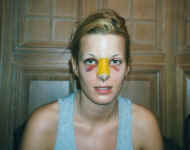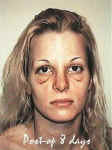The Road to Recovery after Rhinoplasty
Take this as a given: Recovery after rhinoplasty surgery is not comfortable. You won't be in huge amounts of pain, or at least you shouldn't be, but there will be bruising and swelling as well as a stuffed up feeling for at least the first few days.
For additional detailed information on rhinoplasty recovery, or for other facial plastic surgery procedures, such as recovery from eyelid surgery, visit All About Facial Rejuvenation.
If your surgeon has given you prescriptions for pain relievers and antibiotics, get the prescriptions filled in advance so that you have them ready when you get home. Take the antibiotics on time and take them for as many days as you are instructed to.
Don't try to tough it out by not taking pain relievers. If you need them, take them. You will use less pain medication if you take it when the pain starts rather than waiting for the pain to be unbearable.
You may or may not have nasal packing, which is stuffed up your nose to help reduce swelling and bleeding. Packing will make you feel like your whole head is stuffed up and sometimes it can make you feel as if you were smothering. Some people feel overwhelmed a bit by having the packing in their nose. The swelling in your nose may feel like a lot of pressure in that area and can also be a bit upsetting. Some surgeons place a tube or straw in the middle of the nasal packing to help you breathe a bit easier. Your packing, if you have it, will be removed in a few days at your first postoperative appointment.
Some surgeons do not recommend using cold compresses, so check with your surgeon first. However, swelling and pressure can be relieved by icing and many surgeons strongly recommend this. Some patients report that the best things to ice it down with are bags of frozen peas or frozen raspberries. Just be careful you don't puncture the bag from freezing and thawing. It can be a real mess.
Another good trick is to mix one part rubbing alcohol with three parts water. Put a cup of this mixture into a Ziploc bag and seal it and then put that bag inside another Ziploc bag and seal it and place it in the freezer for a few hours. This freezes into a slushy mixture that can mold to your face. Make two or three of these bags so that one is always ready. You can also purchase cold packs that are specially designed for rhinoplasty recovery.
Remember you will be bruised so don't get too frightened when you look at yourself in the mirror. Most people get two black eyes after nose surgery, so count yourself lucky if you don't. These bruises may increase or darken as they heal, just like any other bruise, and may go through some lovely shades of purple, green and yellow before they face completely. It usually takes about 10 days for the bruising to disappear completely. However, in smokers it can take up to 3 to 5 weeks. So, quit smoking now for a better chance at a smoother and faster recovery.
Take a look at my recovery photos. By the way, not everyone will get a yellow cast, that was a joke and I didn't mind the color at all. A few days after surgery, I went out shopping to the mall, with the bruises, neon cast and all!
| 4 hours postoperative |
 |
| 5 days postoperative |
The evening or next day after your surgery, you may feel very nauseous and may vomit. The vomit may look black in color. This is normal. You swallow a bit of blood during a rhinoplasty and it can make you sick later. Usually, after you throw up, you feel better.If your nausea does not let up, call your surgeon.
For the first week after your rhinoplasty surgery, you should sleep with your head and shoulders raised. If you have a recliner, you can try sleeping there. Your head should be at a 30 degree angle or at least two fluffy pillows worth. Keeping your head raised helps keep the swelling and bruising to a minimum. It can also help ward off postoperative bleeding.
Until your surgeon says it is okay, do not take anything with aspirin or ibuprofen in it. Ask your surgeon about taking arnica, bromelain, or vitamin C. Avoid alcohol for at least 3 weeks postoperatively, as well.
The cast is usually removed 5 to 7 days after surgery. Removal may hurt a little bit. If your sutures are being removed, this may also be slightly uncomfortable.
 |
| The day after the cast was removed (attractive, huh?) |
After your cast is removed, the swelling moves down the face. Some patients report that the area between your top lip and nose becomes slightly swollen and feels stiff for a few several hours, but that's okay, it is part of the rhinoplasty recovery process.
 After your cast is off, be careful not to accidentally hit your nose. Not only will it hurt very badly and possibly traumatize the tissues more than they are, you risk moving your nose out of alignment. Although your bone is pretty much well into fusing back together by now, it is still weakened until it is fully healed.
After your cast is off, be careful not to accidentally hit your nose. Not only will it hurt very badly and possibly traumatize the tissues more than they are, you risk moving your nose out of alignment. Although your bone is pretty much well into fusing back together by now, it is still weakened until it is fully healed.
Most sutures used in a nose job are of the dissolving kind, but they may look like black or dark blue "hairs" sticking out of your nose. You may want to have them trimmed so you don't feel uncomfortable in public.
What to Expect After Rhinoplasty: Taping To Control Swelling and Promote Healing
Although not all surgeons will have you tape your nose, some surgeons feel this helps in healing. Check with your surgeon before trying anything that he or she did not specifically tell you to do.
Nasal taping holds the new nose structure in place to help control healing. The pressure of the tape also presses out the swelling. Some patients tolerate taping very well for long periods, others can't. If you cannot tolerate taping, the signs are usually irritation, redness, and bumps from the tape. Stop taping if this case or try interrupting the process for several days until the irritation clears, then try again.
Taping can be safely performed at any time and as often as you like. Begin immediately after the splint is removed. Do this for at least 6 weeks, at least at night. If you don't mind taping during the day, do it. You can stop taping after 6 weeks, but if you notice some return of swelling it is okay to resume taping.
How to tape your nose?
Wash your nose with mild soap and water and blot dry. Wait 5 to10 minutes. Cut three 1-1/12 to 2 inch strips of half-inch-wide paper surgical tape. Apply the first strip across the top of the nose just behind the tip and press down gently on the sides and cheek as you apply the tape. Apply the second strip just under the tip of your nose and press the sides of the tape up on the sides of your nose to support the tip. Pinch the edges together at the tip to apply gentle pressure and support. Apply the third strip of tape over the first. Repeat this daily, or twice daily, if you can tolerate it.
Almost all the swelling in your nose will be gone by a month postoperatively. But it takes about a year for the swelling to completely subside. Just when you think it is looking great, it looks even better!
Hiding Black Eyes
After the cast comes off and the initial swelling subsides, many of us still have bruising and look like a raccoon. There are several brands of color correcting cosmetics that are great for hiding the discolorations after surgery. Don't apply any cosmetics to your face until your surgeon says that it is safe to do so. When you do start using cosmetics, apply them gently.
Helping Your Body Rid Itself of Bruises
Some surgeons suggest alternating between cold and warm compresses starting a few days after surgery to help eliminate residual bruising and swelling. Check with your surgeon first before you start this. This increases blood flow to the area can help the bruises fade.
Skincare After Surgery
After rhinoplasty, your skin may break out either from the medications, the cast adhesive, or simply from the swelling exerting force on the sebaceous glands. This is common and will eventually pass. After your cast is removed, be very careful with your nose and use a very mild cleanser. It is usually not best to use anything that could inflame your healing tissues. Be careful not to use very hot water as your nose may be numb. You might not feel the high temperature and possibly damage your healing tissues.
Peeling Skin
Your nasal skin and the surrounding areas may peel a week or two after your surgery because the swelling may have stretched your skin. However, this does not happen to everyone. Your skin may also feel sunburned from the swelling. This, too, shall pass.
